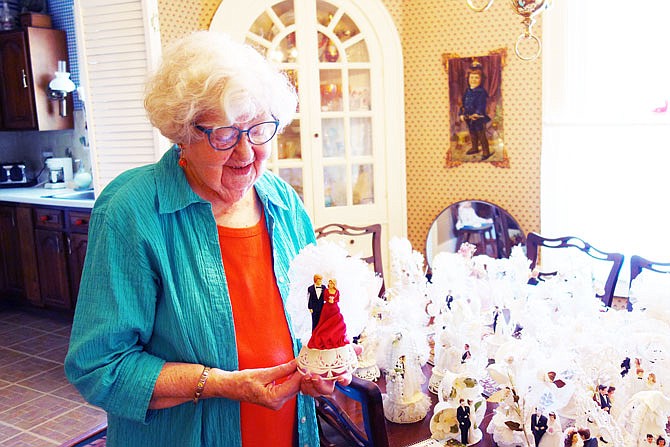Wedding cake topper collector Barbara Binger always feels a little melancholy when she spies one at an antique store.
"The day when you get married is such a high point," Binger said. "And these little sweet fluffy things are like a symbol of the wedding. People hang on to these from the time they're married until they die or divorce."
When Binger finds one for sale, she can't help but wonder what happened.
"I don't know whether to be happy or sad when I see one on the market," she said.
But she tries to give the little figurines a happy ending: They come to join her collection of 120-plus antique and modern wedding toppers at her Fulton home.
Treasures from Binger's collection will be on display from 2-4 p.m. July 28 at the Kingdom of Callaway Historical Society's "Wedding Fashion and Fun!" show, at Court Street United Methodist Church. The event will also include a fashion show with antique wedding dresses and delicious baked treats.
For tickets visit or call the Kingdom of Callaway Historical society at 573-642-0570. Tickets cost $12 and may also be purchased at the door.
Always an antique enthusiast, with a self-described "collection of collections," Binger started collecting cake toppers in her 50s. (She's now 86.) To her knowledge, few people were collecting them at the time. They're more popular now. Hers were even featured on a line of Hallmark cards and other products.
"I paid $2 for my first one, but now you pay at least $30," she said. "The antique business is like a grapevine - word gets around about what people are buying."
The cake toppers are protected from dust in several glass cases positioned around Binger's living room. The topper from her own wedding has a place of honor. The tchotchkes were an object of fascination among her grandchildren, Binger said, but the cases kept the toppers safely out of reach. Now that her grandchildren have grown, she's allowed them to pick toppers for their own weddings.
Wedding cake toppers became popular in the 1890s, when they were often handcrafted from painted clothespins wearing crepe-paper clothes. Mass production began in the 1920s, when the Sears catalogue began offering them, Binger said.
Most depict a groom in a black suit standing to the right of a bride in white, but there's more variation than one might think, Binger said.
"This one has a pair of birds dressed like a bride and groom," she said.
Others make use of wedding symbols such as bells, rings or swans. The most valuable cake topper in her collection, purchased for $350, is made from a pair of Kewpie dolls in paper clothes. A couple of modern cake toppers in her collection depict same-gender couples.
"Ones with military grooms and (non-white) couples are the hardest to find," Binger said.
Most of the toppers in Binger's collection didn't come labeled with dates, but because the cake topper fashions changed alongside bridal fashion, she's been able to determine ballpark dates for most.
Binger pointed out one bride from the '30s, dressed in a form-fitting white gown. The dress is quite similar to the mermaid gowns currently in vogue, she said.
"What goes around comes around," Binger said. "Each generation wants to establish its own identity, and that's the way it should be."

